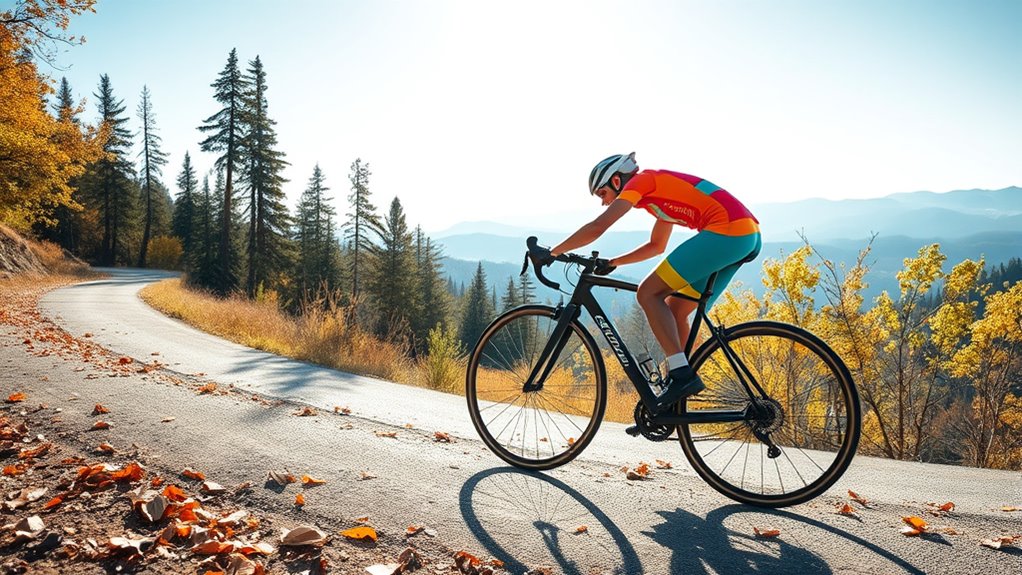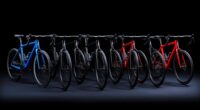Fasted rides can boost fat burning and support weight management, especially when done early in the morning before eating. They rely on your body’s natural fat stores and can improve fat oxidation during moderate efforts. However, they may cause dizziness or fatigue if you’re not careful, and they’re not suitable for everyone. Proper hydration, gradual integration, and listening to your body are key. To discover more about maximizing benefits and staying safe, keep exploring these strategies.
Key Takeaways
- Fasted rides can promote increased fat oxidation and aid in weight management, especially with short, moderate-intensity rides.
- They are best performed in the morning before eating, but longer or high-intensity rides may impair performance.
- Hydration and proper post-ride nutrition are essential to support recovery and prevent dehydration or energy crashes.
- Not suitable for everyone; individuals may experience dizziness, weakness, or reduced performance, requiring careful monitoring.
- Gradual integration and consulting professionals help maximize benefits while minimizing risks and ensuring safety.

Have you ever wondered if riding your bike in a fasted state can boost your performance or enhance fat burning? Many athletes and fitness enthusiasts consider fasted rides as part of their training routines, but understanding the nutrition strategies and training timing behind this practice is vital. When you ride in a fasted state, typically before eating breakfast or several hours after your last meal, your body relies more on stored fat for energy. This can be appealing if you’re aiming to maximize fat loss, as your body taps into fat reserves more readily when glycogen levels are lower. However, the timing of your ride matters. Training early in the morning, before breakfast, aligns with the idea that you’re riding in a fasted state, but it also influences how you structure your overall nutrition strategies throughout the day.
Fasted rides boost fat burning but require careful timing and nutrition strategies.
Incorporating fasted rides into your routine requires careful planning. If you’re doing it for fat-burning benefits, you need to take into account how long you’re riding and your overall energy levels. Short, moderate-intensity rides in a fasted state generally pose less risk and can be effective for fat oxidation. Conversely, longer or high-intensity rides might deplete your glycogen stores too quickly, leading to fatigue or decreased performance. For ideal results, think about your training timing—early mornings might work best because your body is naturally in a fasted state after overnight fasting. This timing allows you to leverage your body’s natural fat-burning window, but it’s vital to make sure you’re properly nourished before and after your workout to support recovery and prevent energy crashes.
Your nutrition strategies should also include hydration and post-ride refueling. Drinking water before and during your fasted ride helps maintain performance and prevents dehydration. After the ride, consuming a balanced meal with carbohydrates, protein, and healthy fats helps replenish glycogen stores and supports muscle recovery. If you’re planning regular fasted rides, it’s important to listen to your body. Some people thrive on this approach, feeling energized and leaner, while others may experience dizziness, weakness, or reduced performance. The key is to integrate fasted rides gradually into your routine, ensuring they align with your overall training goals and nutritional needs. Additionally, understanding the importance of proper wig care and styling can help you look your best for post-ride activities or Halloween celebrations.
Ultimately, whether fasted rides are right for you depends on your individual goals, your body’s response, and how you manage your nutrition strategies and training timing. When done thoughtfully, they can be a useful tool in your fitness arsenal, but they shouldn’t replace a balanced approach to training and nutrition. Always pay attention to how your body reacts and consult with a healthcare or fitness professional if you’re unsure about incorporating fasted rides into your regimen.
Frequently Asked Questions
Can Fasted Rides Improve Fat Burning More Than Fed Rides?
Fasted rides can enhance fat burning more than fed rides because they promote metabolic benefits like increased fat oxidation. When you ride on an empty stomach, your body relies more on stored fat for energy, which may also support endurance adaptation over time. However, you might experience decreased performance or energy levels, so listen to your body and balance fasted rides with proper fueling to maximize benefits and stay safe.
Are There Specific Cycling Types Better Suited for Fasted Training?
You’ll find that interval training and hill climbing are especially suited for fasted rides, because they challenge your body to burn fat efficiently without immediate energy from food. When you incorporate these cycling types into fasted training, you might boost fat burning and endurance. Just remember to listen to your body, stay hydrated, and avoid pushing too hard if you feel dizzy or overly fatigued.
How Does Hydration Impact Safety During Fasted Rides?
Hydration plays a vital role in your safety during fasted rides by maintaining electrolyte balance and preventing dehydration. You should follow effective hydration strategies, like sipping water regularly and including electrolyte drinks if needed. Proper hydration keeps your muscles functioning well, reduces fatigue, and minimizes risks like cramping or dizziness. Staying well-hydrated ensures you can ride safely and efficiently, especially when fasting, so pay attention to your body’s hydration cues throughout your ride.
What Are the Long-Term Effects of Regular Fasted Cycling?
Regular fasted cycling can promote metabolic adaptation, helping your body become more efficient at burning fat for fuel. Over time, it may support muscle preservation by encouraging your body to use fat stores instead of muscle tissue. However, long-term effects vary; some may experience improved endurance, while others might face muscle loss or fatigue if not balanced with proper nutrition. Listen to your body and adjust accordingly for sustained benefits.
Is Fasting Before Rides Suitable for Beginner Cyclists?
Imagine starting a new ride like learning to dance—timing and balance matter. Fasting before rides isn’t ideal for beginners, as it can affect cycling safety and energy levels. It’s best to follow fasting guidelines carefully and eat a light snack if needed. As a beginner, focus on fueling properly to build confidence, avoid fatigue, and enjoy your ride safely. Trust your body’s signals and progress gradually.
Conclusion
Fasted rides might boost fat burning and boost mental clarity, but they aren’t for everyone. Some believe your body becomes more efficient when you train on an empty stomach, but research shows performance can suffer without proper fuel. So, if you’re curious, try it carefully—listen to your body. Ultimately, whether you gain an edge or just feel drained depends on your goals and how you approach it. Stay safe, and find what works best for you.









